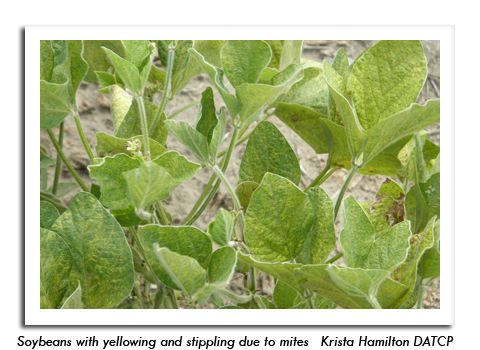
 |
|
|
Looking Ahead
Volume 57 Number 16 Date 08/02/2012 SOYBEAN APHID - Densities have increased to moderate levels in a very small percentage of fields since late July, but remain abnormally low in most areas. Two R2-R3 fields in Buffalo County had individual plants with 420-630 aphids per plant, and averages of 38 and 56 aphids per plant. Soybean fields such as these are at risk of developing economic densities in 1-2 weeks and may require treatment by mid-August. All soybean acreage should be examined in the immediate future to evaluate aphid densities. Final treatments must be applied before the R5.5 growth stage. CORN ROOTWORM - The annual beetle survey is now in progress and preliminary results show minor population reductions in the central and south-central areas, which is contrary to July field observations that found the beetles to be extremely abundant in alfalfa, soybeans and vegetable crops. The average count in the central district is 0.5 per plant as of August 1, a decline from 0.8 per plant in 2011. In the south-central area, the average is 1.0 per plant, compared to 1.4 per plant last year. The survey will continue next week in the remaining crop districts and should be completed by mid-August. EUROPEAN CORN BORER - Egg deposition is expected to continue for another 1-2 weeks. The treatment window for second generation larvae has closed near Beloit, Madison, La Crosse and Sullivan, and remains open only a few more days in the southeast and central districts. Final inspections for egg masses and small larvae should be conducted before 2,100 degree days (base 50°F) are surpassed. Larvae in the southern areas are predominantly in the second and third instars, although some are in the more advanced fourth instar. JAPANESE BEETLE - Locally heavy populations have been observed or reported in Chippewa, Dane, Dodge, Dunn and Eau Claire counties in the past week. Thus far damage has not exceeded the economic threshold of 20% defoliation for soybeans in the bloom-pod fill stages or three beetles per ear for silking corn, but levels are approaching these thresholds and continued monitoring of soybeans and late-planted corn is recommended. TWO-SPOTTED SPIDER MITE - This mite continues to be the leading problem for Wisconsin soybean growers. Numerous soybean fields showing severely bronzed, stippled leaves, and in extreme cases, leaf drop, have been noted in all areas of the state in the last 3-4 weeks, although the problem is most pervasive the southern and central areas. A large acreage of soybeans has been sprayed in recent weeks and repeated applications may be required for many sites. --Krista Hamilton, DATCP Entomologist 





|
|
|